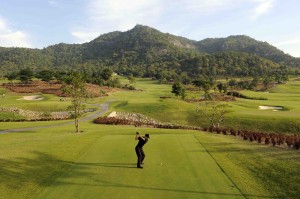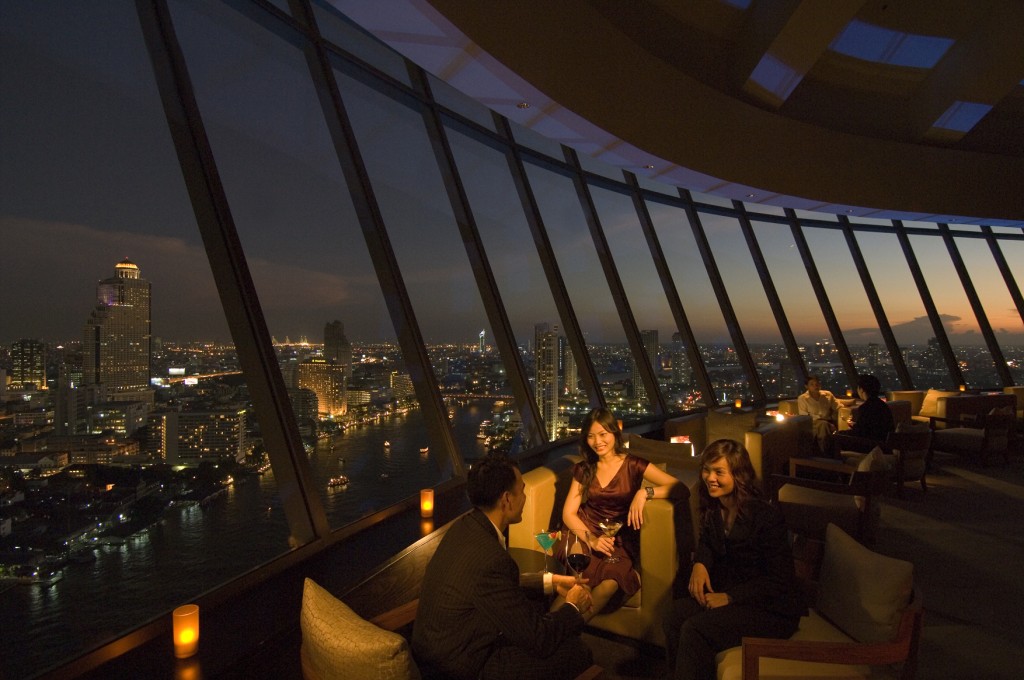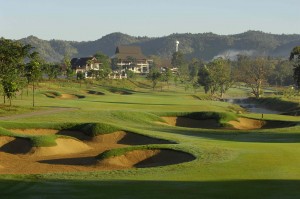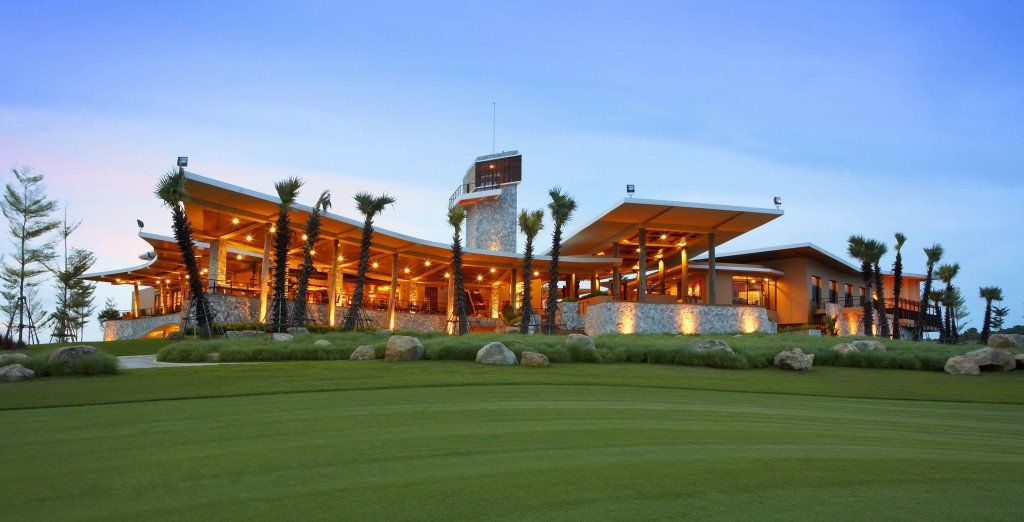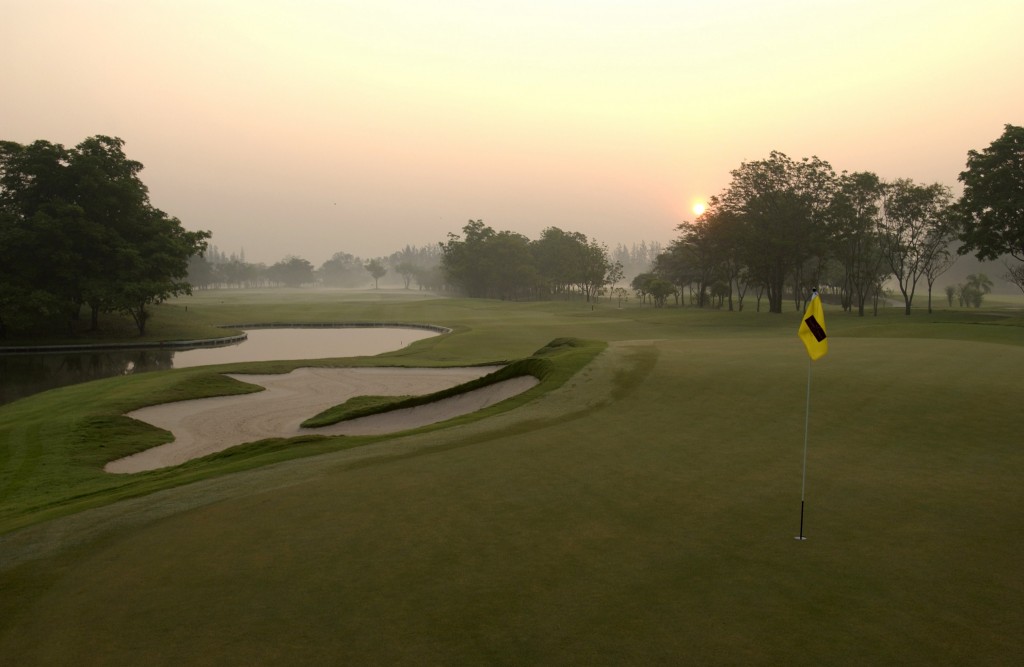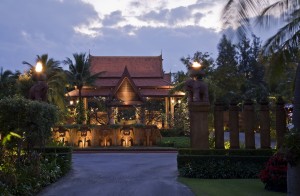[This piece is from Sept 27, 2010. See more of Hal’s writing at his website, Small-Batch Journalism & Comment]
Strolling down the main drag in Pattaya, Thailand, the local clocks ticking toward 11 p.m., I am reminded of the golf destinations we North Americans regard as desirable.
Front and center is the golf component, of course. Normally it’s the primary factor in determining quality or desirability. But there’s no denying that packs of (primarily) male golfers generally prize golfing locales for their nightlife, too. Any gaggle of 8-12 golfing buddies will include a few lads determined to rip it up each night, though their desires are often offset by a few compatriots who’d just as soon play poker in the condo. And so there is equilibrium. However, still, it seems the destination must offer some degree of lascivious attraction — if only to get the hard-partying faction on the plane. Think Myrtle Beach and its strip of nightclubs and bars. Think Vegas and its many diversions.
I consider the different buddy trips I’ve experienced, in these very locales, and I laugh to myself as another sultry Thai evening obliges me to wipe the beads from my perspiring brow. The Walking Street in Pattaya, ground zero for the city’s famously over-the-top nightlife, frankly makes an evening in Vegas look like a night in Amish Country.
Blocked to vehicular traffic (save a series of small open-air trucks that continuously circle the downtown area, picking up patrons and dropping them off, for a dollar), Pattaya’s Walking Street stretches several kilometers along the beachfront. Either side of this thoroughfare is fairly well riddled with some of the craziest nightclub scenes you can possibly imagine. If you’ve never been to Thailand, you will have to imagine it — because you’ve surely never seen anything like it.
This is the primary take-away from my 10 days golfing across Thailand: There is such a breadth of experiences to be had that, after a point, all comparisons tend to pale.
For starters, it’s a big country — from Chiang Mai in the north to Phuket in the south it’s some 750 miles, or about the distance from Boston to Myrtle Beach. In other words, it’s too big to be climatically or culturally monolithic. This explains the striking contrast between the cool-highlands of mountainous Chiang Rai, hard by the Burmese and Lao borders, and the utterly tropical environs of Koh Samui, an island off the east coast of Thailand’s tendril-like southern reach, in the Gulf of Siam. Chiang Mai feels loose and slightly bohemian, like an overgrown backpacker haven, while Bangkok is the picture of a glittering, modern, bustling, gargantuan metropolis; Hua Hin is a quiet, gracious, retiring, seaside retreat while Pattaya… isn’t.
While the airport in Phuket accepts international arrivals from hubs like Singapore, most international visitors disembark via Bangkok, if only to go somewhere else. And so we did, immediately connecting to Chiang Mai where our early November arrival coincided with Loy Krathong, a festival marking the full moon. Krathongs are little cup-shaped flowers, each with a candle and incense stick tucked inside; Loy Krathong means “floating Krathongs.” Our first night in town we ate dinner by the Ping River and watched thousands of these illuminated devotionals drift past. This marvelous scene and a stupendously sweet-and-spicy Burmese-style curry made for a keen introduction to the north country.
Next day we were off to Chiang Mai Highlands, home to 18 holes designed by the America duo of Lee Schmidt and Brian Curley. The superb terrain here made their job easy, but the finer touches impress: Profuse bunkering, pleasing to the eye, frames the inside of most every dogleg. The verdant peaks in the distance, the immaculate conditioning, the dryer heat all give the impression of playing somewhere east of San Diego.
The north is a different brand of Thailand, slower and less insistent. After a cabana attendant offered me an iced towel — these weigh stations/snack pagodas come every 4 holes or so — she clasped her palms together, as in prayer, and, smiling contentedly, nodded over them. Just 36 hours in Thailand and gesture was reflexive in me, so I returned the gesture — a spiritual, though not religious, recognition of the divinity the Thais believe resides in each of us.
At the Robert Trent Jones II-designed Santiburi Chiang Rai Country Club — an hour north, where Burma, Laos and Thailand meet to form the famed Golden Triangle — the landscape proves lush, sweeping and equally divine. The holes feel as if they’ve been cut from a jungle, and so they have. Pleasing trade winds cool things down a bit further; it looks, feels and plays like a top-flight Hawaiian track — at one-third the price.
•••
Back down south in Pattaya — some 90 minutes by car from Suvarnabhumi, Bangkok’s shiny new airport — we presage our adventure on the Walking Street with a pair of rounds at 36-hole Siam Country Club, host to the 2009 and 2010 Honda PTT LPGA Thailand. The Plantation Course reminded me again of Hawaii — the Big Island this time, with its huge scale and colorful purple-hued undergrowth framing the fairways — while the Old Course feels like a private club in the Carolinas somewhere.
That night we took in several Singha and another killer curry (green this time) before swallowing hard and heading for the bright lights.
The Walking Street nightclubs themselves run the gamut in theme and tone, from the brazenly sexual to the coyly geisha, from the darkly gothic to the high camp. On this night we spent 20 minutes — or the time it took us to dispatch an ice-cold Singha — watching a group of 15 topless women dance amongst themselves (with various levels of enthusiasm) on a stage flanked on three sides by stadium-style seating. It was dimly lit and the décor was entirely black and red. Sorta grim. From there we braved a small side street and happened upon a totally different sort of place: cheerful lighting, an outer space theme. Same sort of central, raised dance floor but the mood was leavened 10-fold by the presence of suds, trapeze bars and flexible polyurethane tubes, which the dancers playfully wielded against each other’s backsides, and those of patrons, witting or otherwise as they walked near the stage. It was as if “Josie and the Pussycats in Space” had gone live action and gotten really, really naughty.
I don’t want to make myself out as some naïf. A great many of the patrons were on hand, as I was, for the mere spectacle. But others were clearly on the prowl. Each dancer, after all, wore a number. A mere wave of the hand would summon her to one’s table. After obliging to buy her a few drinks (thereby generating revenue for the club), one is free — or, rather, one is free to pay $50-100 — to bring her back to a motel for the evening.
Again, one is prone to comparison. I was reminded of the North American strip joints that we’ve all been exposed tom, at one time or another, as adjuncts to golf trips or bachelor parties or whatnot. It’s made quite clear to any patron of these establishments that nothing, and I mean nothing is going to happen between you and the hired help. Ever. Chris Rock wrote an entire monologue on the subject that sums it up quite well: “There is no sex in the champagne room.” It’s always confused me, the allure of these places. I mean, one can stuff all the money one likes in a G-string, but she is not going home with said stuffer — and that is ironclad.
In Thailand, that stricture is removed. Utterly. It’s a bit dizzying to contemplate frankly, a bit unreal, and while we could debate the moral merits of this system — clear objectification vs. straightforward commerce — what strikes me is the clarity, legality and transparency of the exercise when set against the equivalent here in the states.
Whether too smart or too cowardly, no one in our group took the plunge in Pattaya, or anywhere else in Thailand for that matter (there are Walking Street equivalents in every city of any size). We stumble out of the space bar back onto the teeming streets which, when I look closely, are peopled by men, women and children of two dozen different nationalities. Everyone looks to be on holiday, heads on a swivel, eyes wide. It’s more reminiscent of a circus midway than a den of iniquity. It’s an assault on your senses, each and every one. To that end, I buy several divine, street-vended skewers of fried squid and satay chicken before heading back to the hotel with my compatriots. On the spur of the moment we decide to get a massage at one of the dozens of parlors around the corner from our hotel, the plush Woodland Suites.
Again, there are plenty of establishments in Pattaya where the word “massage” is just a device, a front — but far more deliver nothing more than the finest $8 massage you’ve ever had. An oil massage is what you’ve probably had elsewhere; a Thai massage involves no oil and can be quite a workout. After 72 holes in four days, there’s a whole lot to be said for either approach.
•••
You’ll never rake a bunker in Thailand. In the Kingdom, that’s a caddie’s job and it’s but one benefit of the country’s utter reliance on 80- to 115-pound loopers. Yes, they’re all female and they’re a constant at every course in Thailand. Take a cart? They’ll drive it. Feel like driving? They’ll ride on the back. Walking? They’ll pull the trolley. All of this is done with unfailing courtesy and a solid understanding of the course. Club selection? I’d handle that yourself — but that’s my feeling toward all caddies.
In a place like Thailand, with its walking streets and massage parlors, the whole caddie phenomenon tends to elicit raised eyebrows from the uninitiated, but trust me: There is absolutely nothing sexual about the Thai caddie experience. For starters, despite the heat, they are completely swathed in clothing from head to toe, complete with long sleeves and gloves. Such is the standard of female beauty in Thailand: Tans are not fashionable for women, at all, and caddies go to great lengths to avoid them. Second, they are all business. In most cases they are far too busy fixing ball marks, putting sand in divots and raking bunkers to flirt with you.
Some of the best caddies we experienced were served up back in Bangkok at the sporty Muang Kaew Golf Club, where conditions included near-100 degree temperatures and not a breath of wind. Our caddies never wavered — until we did. My two playing partners and I ditched the back nine, paid full caddie fees, and made three friends for life. Then we went for a massage in the clubhouse, a typically sterling facility in a country where they hew to a very high standard.
Asian clubhouses in general make their American counterparts look downright dowdy. Yet because Thai clubhouses cater to so many Asian golfing tourists, they are borderline palatial — how else to impress the Japanese or Korean who is used to merely opulent clubhouses back home? Massage rooms are standard fare in Thai clubhouses. Locker rooms are cavernous, as each golfer is assigned a locker at no charge, as a matter of course. After the round one is expected to shower, don a change of clothes, and kick back for several hours in the bar or restaurant. It’s a damned fine ethic, if you ask me.
The clubhouse at Thai Country Club has for several years been voted the best in Asia, and it’s not difficult to see why. It has all the bells and whistles, plus a superb restaurant (yellow curry this time, with chicken-lime soup) and an epic hot tub big enough to accommodate you and 11 of your closest friends. The course at TCC is no slouch — good enough to have hosted several tour events, including Tiger’s first foray in Thailand, the 1997 Asia Honda Classic. Despite all his issues of late, Tiger’s name remains emblazoned on locker no. 1 at Thai Country Club. At least, it was when I visited…
Because Bangkok is the center of Thailand’s ancient culture — a culture, a nation that was never colonized by a Western power — it is naturally home to myriad examples of impossibly grand, ornate Thai architecture, each one more elaborate and awe-inspiring than the last. I recommend taking a cruise up and down the Chao Phraya River, which affords passengers a veritable water-born palace and temple tour. The swank Bangkok Marriott Resort & Spa, where we stayed, has it’s own boat — the dinner cruise is not to be missed.
With all this history, and with all our western prejudices on board, it’s startling to travel around Greater Bangkok (and indeed all of Thailand) with such ease. Bangkok traffic is world-renowned, but super highways connect the entire country, a monorail runs between downtown BKK and the gleaming new airport at Suvarnabhumi, and there are all manner of cheap domestic flights. This is clearly a first world country where everything still goes for second and third world prices.
We finished our Thai journey — arranged through the tour operator Golfasian (www.golfasian.com), roughly along an itinerary comprised of resorts and hotels belonging to Golf in a Kingdom (www.golfinakingdom.com) — with a few days in the semi-sleepy town of Hua Hin, about 2 hours southeast of the capital on the Gulf of Siam. At the turn of the last century, the Thai royal family decided they liked this place, then just a village called Samoriang. The royals authorized a railway station here and commissioned fancy Italianate hotels. Then King Rama VI hired a Scot, A.O. Robins, to design the country’s first course, Royal Hua-Hin GC.
The rest is history. Today there are 275 golf courses and some 2 million native players, a figure that places them behind only the golf-mad Japanese and Koreans. Of course, all the courses in Japan and Korea are private, so where do they go on golf holiday? Thailand.
After waking up in a tropical garden that doubles as the Anantara Hua Hin, we decamp for our final round of the trip. It’s fitting that we close it down with 18 holes at Banyan Golf Club. Not because it was voted (by Asia Golf Monthly magazine) the best new course in Asia-Pacific for 2009, but because it was designed by the Thai architects at GolfEast — and because, as is the case at most Thai courses, one is just as likely to be playing behind a group of Thais as a group of Kiwis, Finns or Singaporeans.
Banyan was laid out over a former pineapple plantation, a giant bowl-shaped plateau set in the foothills above the sea (you get a peak at the Gulf of Siam from the picturesque par-3 15th). The striking modernist clubhouse looks out over the property from a commanding perch and it’s here that my golfing companions contemplate the genius of Thai golf over these final few Singha (and yes, one last curry).
It’s the organic quality of the golf culture here that resonates, we decide. Unlike some Asian nations where golf is nothing but a modern development gambit, or others where a colonial overlord foisted golf on the culture, Thailand came to the game on its own. The Thais really do love their golf. We decide they have every right to feel that way: We love it, too.
For more information on Thai golf vacations, visit www.golfasian.com and www.golfinakingdom.com

